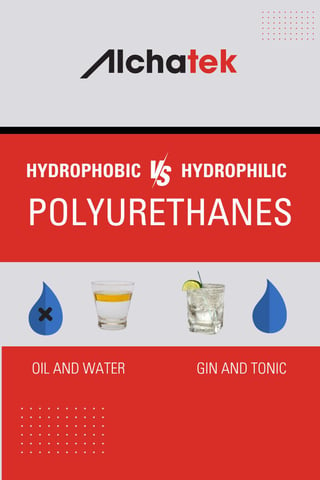
The terms hydrophobic and hydrophilic may not mean anything to the average person. But, to a contractor, these terms can mean a world of difference. Hydro means water while phobic means “to fear” and philic means “to love”. Alchatek offers both hydrophobic and hydrophilic polyurethanes, so it is important to be aware of the differences between the two types.
Hydrophobic Polyurethanes
 Hydrophobic polyurethanes naturally repel water (similar to the way oil would repel water and stay separate if you were trying to mix them in a glass). These products push water out of the area in question as they expand. Hydrophobics are used with catalysts which allow you to adjust the set time. They also have zero shrinkage after curing.
Hydrophobic polyurethanes naturally repel water (similar to the way oil would repel water and stay separate if you were trying to mix them in a glass). These products push water out of the area in question as they expand. Hydrophobics are used with catalysts which allow you to adjust the set time. They also have zero shrinkage after curing.
Check out these hydrophobic polyurethanes:
- Spetec PUR HighFoamer
- Spetec PUR F400
- Spetec PUR H100
- Spetec PUR H200
- AP Fill 420
- AP Deep Lift® 420
- AP Lift 430
- AP Lift 435
- AP Lift 440
- AP Lift 475
- AP Soil 600
- AP Fill 700
- AP Fill 720
Hydrophilic Polyurethanes
Hydrophilic polyurethanes naturally mix with water before curing (similar to the way gin and tonic mix thoroughly in a glass). This characteristic allows for a very strong chemical and mechanical bond, as water helps pull the material into the pores of the concrete. These products do not require a catalyst. You can pump them straight out of the pail.
Check out these hydrophilic polyurethanes:
Don't Oversimplify These Concepts
Don't get caught in the trap of oversimplifying hydrophilic vs. hydrophobic. There are varying degrees of each (see chart below for more information on how this is measured).

Some hydrophilic materials will keep absorbing water (10-15 times their original volume). Others (such as Spetec PUR GT500) only absorb as much water as is necessary for their reaction and then they reject the rest. Yes, hydrophilic gels will shrink like crazy in the absence of water, but Spetec PUR GT500 won't. It is completely safe to use in a dry environment.



